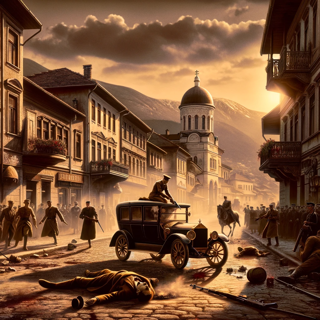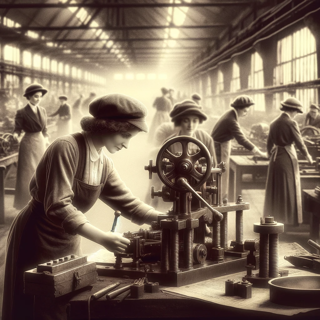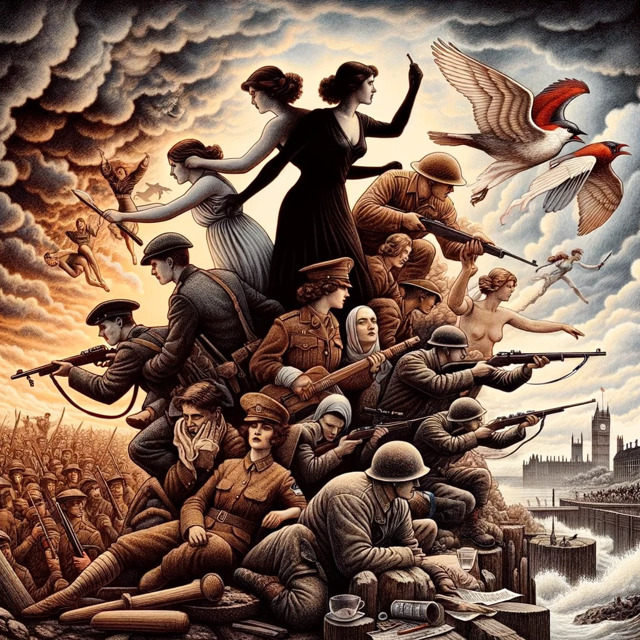January 2024
In this insightful journey, we uncover the stories of unprecedented opportunity that arose amidst the chaos. The war's tumultuous years brought unforeseen opportunities, particularly for women, who stepped into roles traditionally held by men, forging new paths in a society in transition. However, the scars of the war were deep, leaving indelible marks on the psyche of soldiers and civilians alike. We examine the physical and psychological wounds that shaped cultural attitudes and fostered a profound sense of disillusionment.
Last updated 18 months ago
Will publish on 06/07/2026
Living on the Fringe: World War I
By Monica Granlove

In the tumultuous years preceding World War I, a intricate interplay of political, economic, and nationalistic forces unfolded, shaping a volatile geopolitical landscape in Europe. Rivalries for power, imperialistic pursuits, and territorial disputes laid the groundwork for a conflict that would reverberate across social, political, and economic realms.
In the novel, The Surgeon and the Soldier we are transported from England to the front lines of World War I through the eyes of Ilse, an eighteen year old forced to work in a field hospital, Wilhelm, a professional football player who volunteered to fight for his adopted country and Eli, a German Jew forced to fight in a war he didn’t support.
Against the backdrop of heightened nationalism, the annexation of Czechoslovakia into Austria-Hungary in 1909 fueled simmering discontent. Tensions reached a crescendo when Archduke Franz Ferdinand of Austria-Hungary was assassinated in Sarajevo on June 28, 1914, serving as the catalyst for war. A chain reaction ensued, leading to widespread mobilization and declarations of war, embroiling multiple nations in the maelstrom.
The existing network of military alliances, notably the Triple Entente (France, Russia, United Kingdom) and Triple Alliance (Germany, Austria-Hungary, Italy), transformed regional disputes into a global conflagration. An arms race, fueled by the belief in military prowess as a symbol of national prestige, added fuel to the flames of war.
World War I unfolded with alarming facets, prominently marked by the introduction of trench warfare. Soldiers endured harsh conditions, facing constant threats from enemy attacks, disease, and the unforgiving elements. The conflict witnessed an unprecedented scale of destruction and loss of life, with millions succumbing to combat, disease, and starvation.
Amidst the grim realities, the war spurred advancements in emergency medicine and critical care, addressing challenges in treating burns and preventing infections, offering a glimmer of hope amid the devastation.
The war's global nature involved nations from Europe, Asia, Africa, and the Americas, leaving an indelible impact on worldwide economies, societies, and political structures. The entry of the United States on April 6, 1917, was prompted by significant events altering public sentiment. German U-boats attacking American ships, notably the sinking of the RMS Lusitania in 1915, and the revelation of the Zimmermann Telegram, proposing a German-Mexican alliance against the U.S., heightened anti-German sentiment. Economic and cultural ties with the Allied powers, coupled with the potential jeopardy of American economic interests, further swayed public opinion.
The Treaty of Versailles, concluding the war, imposed severe penalties on Germany, foreshadowing future geopolitical tensions and the eruption of World War II.
The aftermath witnessed revolutions, including the Russian Revolution of 1917, establishing a communist government, and geopolitical instability that fueled political upheavals across nations.

The war brought unforeseen opportunities for women as they assumed roles traditionally held by men. Yet, beyond tangible shifts, the conflict left enduring scars on the collective psyche, with soldiers and civilians grappling with physical and psychological wounds, shaping cultural attitudes and fostering a profound sense of disillusionment that echoed through the ensuing decades.
President Woodrow Wilson, in his address to Congress seeking a declaration of war, outlined idealistic goals based on his vision for a world "safe for democracy." He advocated for a war to end all wars and the establishment of the League of Nations to ensure lasting peace. As we now know, World War I was not the war to end all wars. Hitler exited the League of Nations leading the way for World War II.


